Academy's 1/32 scale
F/A-18+ Hornet
by Steve Pritchard
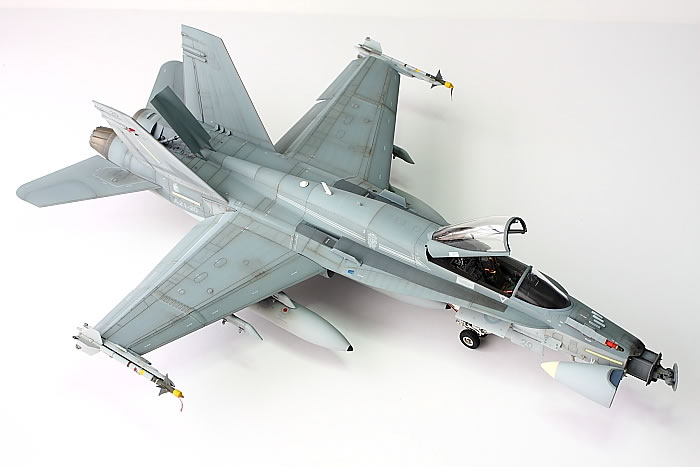 |
F/A-18A+ Hornet |

Academy's 1/32 scale F/A-18A is available online from Squadron
Here is my 1/32nd scale Academy F/A-18a+ (12107) painted in the markings of 77 Sqn RAAF aircraft A21-20.
Summary
Various aftermarket accessories were added, and some parts scratch built:
-
Master model NATO standard refueling probe tip AM-32-030
-
Master model F-16 Pitot tube (not used!) and AOA probes AM -32-032
-
Eduard F-18 Mesh set 32111
-
Eduard F-18 Exterior 32106
-
Eduard F-18 Placards 32508
-
Eduard F/A-18E Avionics Bay 32697
-
Aires F/A-18C Cockpit set 2035
-
Aires F/A-18C Exhaust nozzles – closed 2037
-
Rhino Modelworks F/A-18C/D seamless intakes RM32004
-
Zactomodels Aim 9L/M Sidewinder missiles
-
Southern Sky Models 77 Sqn RAAF 70th Anniversary 2012 decals (including stencil and panel numbering sheets) SSM32049
-
Aussie Decals F/A-18 Hornets – RAAF 75 and 77 Squadrons No: A32013
I had wanted to model an Australian F-18 for some time, and when the A+ Academy kit came out I was quick to order from HobbyLink Japan who delivered it to me in New Zealand in less than a week.
I was lucky enough to see A21-20 when it was based at Christchurch over Easter 2010, when it was in New Zealand in company with three other aircraft to display at the Warbirds over Wanaka airshow. I thought this would be a good subject to model as I now had a few of my own photos for reference.
I decided to add a refueling probe, refueling panel, two avionics bays, an engine bay, and some detail to one of the engines.
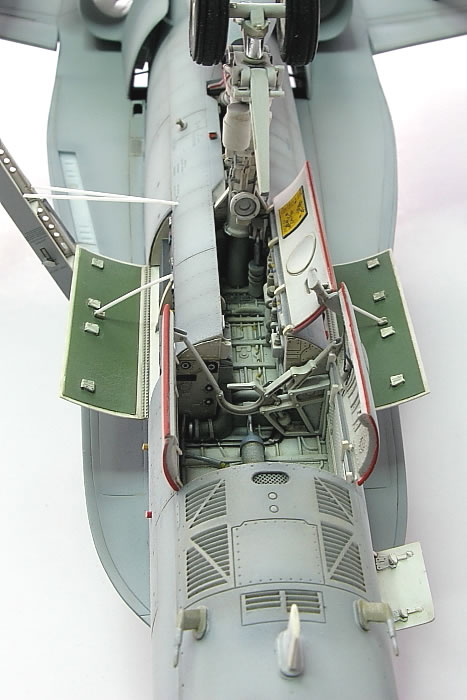
My principal reference was the excellent Daco Publications book ‘Uncovering the Boeing F/A-18A/B/C/D Hornet’, which includes photos from most angles. Unfortunately, the book doesn’t actually feature RAAF Hornets, and the photos of the avionics bays are those of a Canadian Hornet - I am hopeful the Aussie ones are not too dissimilar. I used the Eduard set for F-18E avionics bays – these appeared to be similar to those in early model Hornets, and they fitted in the space available. Even if not strictly accurate, they ‘busied’ up the bays and saved a lot of scratch building.
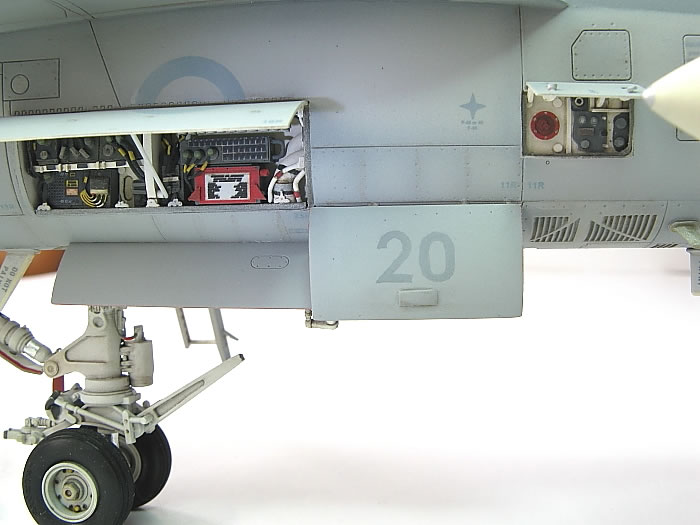
The engine was detailed with engine shaped bits and pieces from the spares box, enough for it to bear a passing resemblance to the real thing, anyway. A21-20 did not have the white coloured nozzle interiors as depicted, in 2010, but certainly many Aussie Classic Hornets do have them now, often on only one engine.
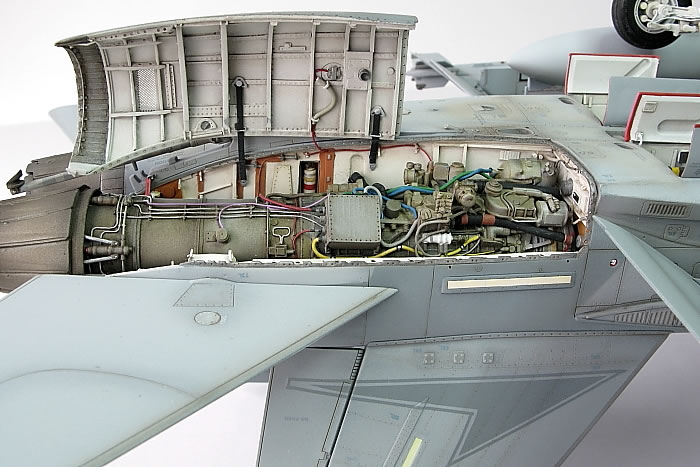
Construction of the kit itself was straightforward, but adding the Aires cockpit was a bit of a struggle. I didn’t use the side walls and the cockpit tub itself needed a lot of sanding to get it to sit on top of the undercarriage bay. So much so that I sanded through the floor and had to repair with plastic card. The avionics and refueling bays where simple card constructions, but the engine bay was a bit more fiddly. It was difficult to judge from photos the exact location, size and shape of the various components, so it was really a case of if it looked reasonably convincing then it would do for me. I note some photos on the net show an orange colour for some areas of the bay, and others show a more uniform white finish. Again, what is correct for an Aussie Hornet is not known to me, so I went with the orange colour as it makes the appearance more interesting.
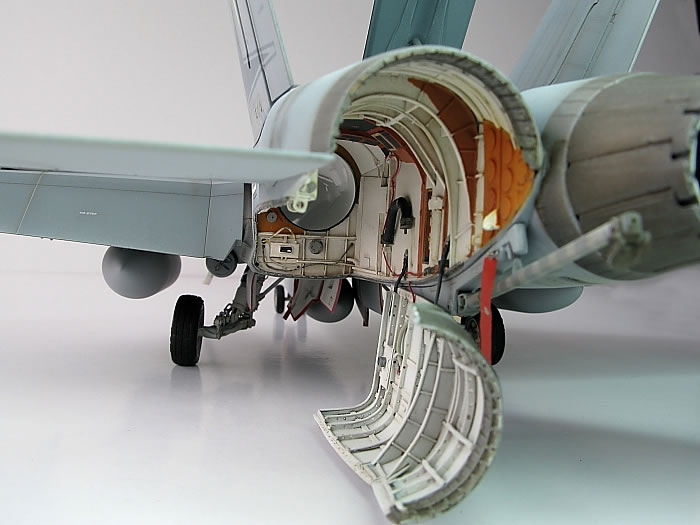
Having read on the net that there is a tendency for the undercarriage legs to sag over time, I strengthened the main legs by gluing the supplied metal support rods in with 5 minute epoxy, hopefully this will provide some extra long term rigidity.
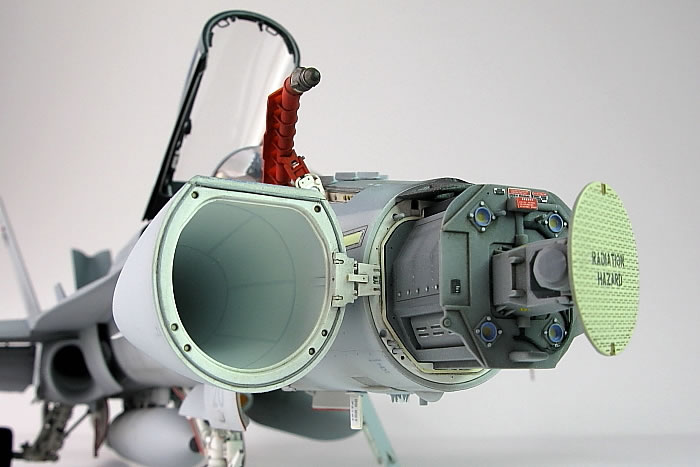
I shaved some plastic off the top of the four wing pylons, which is necessary to give them the quite noticeable downward cant present on the real aircraft- otherwise, the pylons and fuel tanks would have sat parallel to the centerline tank and the ground, which doesn’t look right. I couldn’t resist adding the Zactomodels Sidewinders, clearly the real aircraft wouldn’t have live missiles fitted when undergoing engine maintenance so I made them removable to eventually fit to my next 1/32nd project, Tamiya’s F-16.
Humbrol paints were used for the main colours, 145 for the upper surfaces and 127 for the lower. Some tonal variation on the top surfaces was applied to break up the large areas – matt white was mixed with 145 and some panels given a lighter overspray. Alclad shades ‘Steel’ and ‘Jet Exhaust’ were used on the exhaust nozzles. An oil paint wash was used to dirty the model up a bit, particularly aft of the main undercarriage bays.
Squadron markings were generally homemade - the Squadron crest or ‘grumpy monkey’, though, came from the Aussie Decals sheet, but had to be repainted in the low-viz scheme worn by A21-20 in 2010. A mix of stencils from the Southern Skies and the kit decal sheets were used.
All in all a very enjoyable build - all that remains is to find somewhere to store it safely. Fluff the cat has already shown some interest in nibbling the sidewinders.
Steve Pritchard
Christchurch
New Zealand
Model, Images and Text Copyright ©
2015 by Steve Pritchard
Page Created 14 January, 2015
Last Updated
8 January, 2015
Back to HyperScale Main Page

|
Home
| What's New | Features | Gallery | Reviews | Reference | Resource Guides | Forum |